-
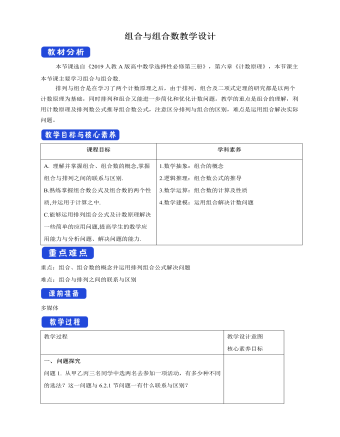
人教版高中数学选修3组合与组合数教学设计
解析:因为减法和除法运算中交换两个数的位置对计算结果有影响,所以属于组合的有2个.答案:B2.若A_n^2=3C_(n"-" 1)^2,则n的值为( )A.4 B.5 C.6 D.7 解析:因为A_n^2=3C_(n"-" 1)^2,所以n(n-1)=(3"(" n"-" 1")(" n"-" 2")" )/2,解得n=6.故选C.答案:C 3.若集合A={a1,a2,a3,a4,a5},则集合A的子集中含有4个元素的子集共有 个. 解析:满足要求的子集中含有4个元素,由集合中元素的无序性,知其子集个数为C_5^4=5.答案:54.平面内有12个点,其中有4个点共线,此外再无任何3点共线,以这些点为顶点,可得多少个不同的三角形?解:(方法一)我们把从共线的4个点中取点的多少作为分类的标准:第1类,共线的4个点中有2个点作为三角形的顶点,共有C_4^2·C_8^1=48(个)不同的三角形;第2类,共线的4个点中有1个点作为三角形的顶点,共有C_4^1·C_8^2=112(个)不同的三角形;第3类,共线的4个点中没有点作为三角形的顶点,共有C_8^3=56(个)不同的三角形.由分类加法计数原理,不同的三角形共有48+112+56=216(个).(方法二 间接法)C_12^3-C_4^3=220-4=216(个).

新人教版高中英语必修3Unit 1 Festivals and Celebrations教学设计二
1. Ss look at the picture and scan the passage to understand the main idea while teacher is giving the following questions to inspire Ss to think.*Where are those people?*What are they doing?*Why are they so excited?2. Ss complete the passage with the appropriate -ing form. Then discuss and check the answers with class.Answers: boring, interesting, taking, exciting, amazing3. The teacher raises questions for the students to discuss and encourages them to express their opinions.*Do you like La Tomatina? Why or why not?4. Each group representative reports the discussion result, the teacher gives feedback and the evaluation.Step 6 PracticeActivity 41. Ss complete the Ex 2 in Using structures.2. Check the answers after finishing the exercises.①The dragon boat races are the most exciting part of the Dragon Boat Festival.② The children were excited to go Easter egg hunting.③What an amazing performance! This is the best music festival I have ever been to.④We were amazed by her funny-looking hat.⑤His inspiring speech at the conference won the admiration/ favour of the audience.⑥This is a challenging game to test your memory and observation capabilities. 3. T asks Ss to finish Ex 3 and 4 in Using structures by themselves, then check the answers with class.Step 6 Homework1. Understand and master the functions and usage of the -ing form;2. Finish the other exercises in Using structures.1、通过本节内容学习,学生是否理解和掌握动词-ing形式作定语和表语的功能和意义;2、通过本节内容学习,学生能否在理解文段内容的基础上,根据上下文语境和表达逻辑,能正确运用动词-ing形式描述节日庆典。3、通过本节内容学习,学生是否归纳和积累用于表达情绪的相关词汇。

新人教版高中英语必修3Unit 2 Morals and Virtues教学设计二
Activity 41. Students complete the task of activity 4, then teachers and students check the answers. 2. The teacher organized the students to work together and asked them to use the tables and mind maps sorted out before to retold the important choices in Lin Qiaozhi's life and their resultsStep 5 Language points1. The teacher asks the students to read the text carefully, find out the core words and long and difficult sentences in the text and draw lines, understand the use of vocabulary, and analyze the structure of long and difficult sentences. 2. The teacher explains and summarizes the usage of core vocabulary and asks the students to take notes. 3. The teacher analyzes and explains the long and difficult sentences that the students don't understand, so that the students can understand them better. Step 6 Homework1. Read the text again, in-depth understanding of the text; 2. Master the use of core vocabulary and understand the long and difficult sentences. 3. Complete relevant exercises in the guide plan. 1、通过本节内容学习,学生是否理解和掌握阅读文本中的新词汇的意义与用法;2、通过本节内容学习,学生能否结合文本特点总结林巧稚的人生原则和人格品质特征;3、通过本节内容学习,学生能否针对人生抉择发表自己的看法;能否全面地、客观地、理性地看待问题,进而对道德和人性有更加深入的思考和理解。

新人教版高中英语必修3Unit 2 Morals and Virtues教学设计四
3.Teachers ask different groups to report the answers to the questions and ask them to try different sentence patterns.The teacher added some sentence patterns for students to refer to when writing.Step 4 Writing taskActivity 51.Write the first draft.Students first review the evaluation criteria in activity 5, and then independently complete the draft according to the outline of activity 4, the answers to the questions listed in the group discussion and report, and the reference sentence pattern.2.Change partners.The teacher guides the students to evaluate their partner's composition according to the checklist of activity 5 and proposes Suggestions for modification.3.Finalize the draft.Based on the peer evaluation, students revise their own compositions and determine the final draft.Finally, through group recommendation, the teacher selects excellent compositions for projection display or reading aloud in class, and gives comments and Suggestions.Step 5 Showing writingActivity 5T call some Ss to share their writing.Step 6 Homework1. Read the passage in this section to better understand the passage.2. Carefully understand the hierarchical structure of the article, and deeply understand the plot of the story according to the causes, process and results;3. Independently complete the relevant exercises in the guide plan.1、通过本节内容学习,学生是否理解和掌握阅读文本中的新词汇的意义与用法;2、通过本节内容学习,学生能否通过人物言行的对比分析道德故事的深层内涵;3、通过本节内容学习,学生能否根据故事的起因、经过和结果来深入理解故事的情节,从而了解文章的层次结构;4、结合现实生活案例发表自己的见解和看法,写一篇观点明确、层次分明的故事评论。

新人教版高中英语必修3Unit 2 Morals and virtues教学设计一
(2) students are divided into groups according to the requirements of activity 3. Each student shares a story of personal experience or hearing-witnessing kindness, and then selects the most touching story in the group and shares it with the whole class. Before the students share the story, the teacher can instruct them to use the words and sentence patterns in the box to express. For example, the words in the box can be classified:Time order: first of all, then, after that, later, finally logical relationship :so, however, although, butTeachers can also appropriately add some transitional language to enrich students' expression:Afterwards, afterwards, at last, in the end, eventuallySpatial order: next to, far from, on the left, in front ofOtherwise, nevertheless, as a result, therefore, furthermore, in addition, as well asSummary: in a word, in short, on the whole, to sum up, in briefStep 8 Homework1. Understand the definition of "moral dilemma" and establish a correct moral view;2. Accumulate vocabulary about attitudes and emotions in listening texts and use them to express your own views;3. Complete relevant exercises in the guide plan.1、通过本节内容学习,学生能否理解理解“道德困境”的定义;2、通过本节内容学习,学生能否通过说话人所表达的内容、说话的语气、语调等来判断其态度和情绪;3、通过本节内容学习,学生能否针对具体的道德困境发表自己的看法和见解,能否掌握听力理训练中的听力策略。
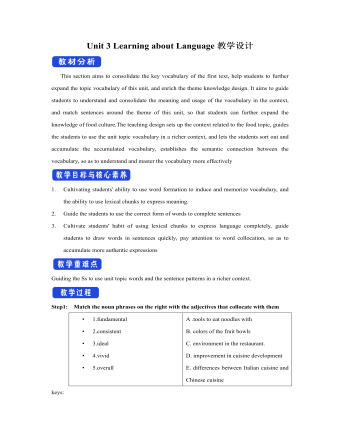
新人教版高中英语选修2Unit 3 Learning about Language教学设计
1. We'll need ten months at least to have the restaurant decorated.2.Some traditional Chinese dishes from before the Ming Dynasty are still popular today.3.My grandpa's breakfast mainly includes whole grain biscuits and a glass of milk.4.People in this area would eat nearly a kilo of cheese per week.5. We enjoyed a special dinner in a fancy restaurant where the waiters all wore attractive suits.6. He prefers this brand of coffee which, as he said, has an unusually good flavor.Key:1. at a minimum 2. prior to3. consist of4. consume5. elegant6. exceptionalStep 5:Familiarize yourself with some food idioms by matching the meaning on the right with the colored words on the left.1.Public concern for the health of farm animals has mushroomed in the UK2.Anderson may be young but he's certainly rolling to doing dough!3.George is a popular lecturer. He often peppers his speech with jokes.4.As the person to bring home the bacon, he needs to find a stable job.5 He is often regarded as a ham actor for his over emphasized facial expressions. The media reported that these companies had treated pollution as a hot potato. 6.The media reported that these companies had treated pollution as a hot potato.7.Don't worry about the test tomorrow. It's going to be a piece of cake!8. It's best to fold the swimming ring when it is as flat as a pancake.A. completely flatB. something that is very easy to do C.an issue that is hard to deal withD.to include large numbers of somethingE.to earn on e's living to support a familyF. wealthyG.to rapidly increase in numberH. an actor who performs badly, especially by over emphasizing emotions
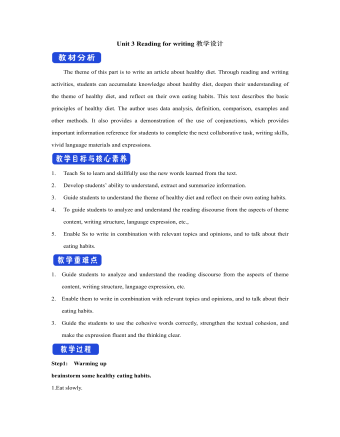
新人教版高中英语选修2Unit 3 Reading for writing教学设计
The theme of this part is to write an article about healthy diet. Through reading and writing activities, students can accumulate knowledge about healthy diet, deepen their understanding of the theme of healthy diet, and reflect on their own eating habits. This text describes the basic principles of healthy diet. The author uses data analysis, definition, comparison, examples and other methods. It also provides a demonstration of the use of conjunctions, which provides important information reference for students to complete the next collaborative task, writing skills, vivid language materials and expressions.1. Teach Ss to learn and skillfully use the new words learned from the text.2. Develop students’ ability to understand, extract and summarize information.3. Guide students to understand the theme of healthy diet and reflect on their own eating habits.4. To guide students to analyze and understand the reading discourse from the aspects of theme content, writing structure, language expression, etc., 5. Enable Ss to write in combination with relevant topics and opinions, and to talk about their eating habits.1. Guide students to analyze and understand the reading discourse from the aspects of theme content, writing structure, language expression, etc.2. Enable them to write in combination with relevant topics and opinions, and to talk about their eating habits.3. Guide the students to use the cohesive words correctly, strengthen the textual cohesion, and make the expression fluent and the thinking clear.Step1: Warming upbrainstorm some healthy eating habits.1.Eat slowly.2.Don’t eat too much fat or sugar.3.Eat healthy food.4.Have a balanced diet.Step2: Read the passage and then sum up the main idea of each paragraph.

新人教版高中英语选修2Unit 3 Using langauge-Listening教学设计
1. How is Hunan cuisine somewhat different from Sichuan cuisine?The heat in Sichuan cuisine comes from chilies and Sichuan peppercorns. Human cuisine is often hotter and the heat comes from just chilies.2.What are the reasons why Hunan people like spicy food?Because they are a bold people. But many Chinese people think that hot food helps them overcome the effects of rainy or wet weather.3.Why do so many people love steamed fish head covered with chilies?People love it because the meat is quite tender and there are very few small bones.4.Why does Tingting recommend bridge tofu instead of dry pot duck with golden buns?Because bridge tofu has a lighter taste.5 .Why is red braised pork the most famous dish?Because Chairman Mao was from Hunan, and this was his favorite food.Step 5: Instruct students to make a short presentation to the class about your choice. Use the example and useful phrases below to help them.? In groups of three, discuss what types of restaurant you would like to take a foreign visitor to, and why. Then take turns role-playing taking your foreign guest to the restaurant you have chosen. One of you should act as the foreign guest, one as the Chinese host, and one as the waiter or waitress. You may start like this:? EXAMPLE? A: I really love spicy food, so what dish would you recommend?? B: I suggest Mapo tofu.? A: Really ? what's that?

新人教版高中英语必修3Unit 1 Festivals and Celebrations教学设计一
本板块的活动主题是“谈论节日活动”(Talk about festival activities),主要是从贴近学生日常生活的角度来切入“节日”主题。学生会听到发生在三个国家不同节日场景下的简短对话,对话中的人们正在参与或将要亲历不同的庆祝活动。随着全球化的进程加速,国际交流日益频繁,无论是国人走出国门还是外国友人访问中国,都已成为司空见惯的事情。因此,该板块所选取的三个典型节日场景都是属于跨文化交际语境,不仅每组对话中的人物来自不同的文化背景,对话者的身份和关系也不尽相同。1. Master the new words related to holiday: the lantern, Carnival, costume, dress(sb)up, march, congratulation, congratulate, riddle, ceremony, samba, make - up, after all. 2. To understand the origin of major world festivals and the activities held to celebrate them and the significance of these activities;3. Improve listening comprehension and oral expression of the topic by listening and talking about traditional festivals around the world;4. Improve my understanding of the topic by watching pictures and videos about different traditional festivals around the world;5. Review the common assimilation phenomenon in English phonetics, can distinguish the assimilated phonemes in the natural language flow, and consciously use the assimilation skill in oral expression. Importance:1. Guide students to pay attention to the attitude of the speaker in the process of listening, and identify the relationship between the characters;2. Inspire students to use topic words to describe the festival activities based on their background knowledge. Difficulties:In the process of listening to the correct understanding of the speaker's attitude, accurately identify the relationship between the characters.
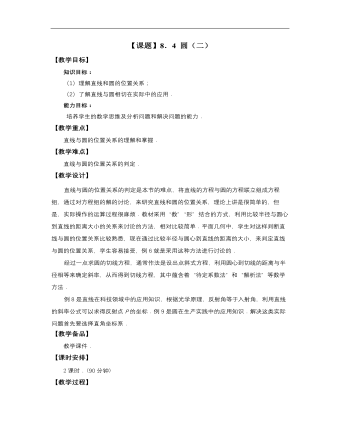
高教版中职数学基础模块下册:8.4《圆》教学设计
教 学 过 程教师 行为学生 行为教学 意图时间 *揭示课题 8.4 圆(二) *创设情境 兴趣导入 【知识回顾】 我们知道,平面内直线与圆的位置关系有三种(如图8-21): (1)相离:无交点; (2)相切:仅有一个交点; (3)相交:有两个交点. 并且知道,直线与圆的位置关系,可以由圆心到直线的距离d与半径r的关系来判别(如图8-22): (1):直线与圆相离; (2):直线与圆相切; (3):直线与圆相交. 介绍 讲解 说明 质疑 引导 分析 了解 思考 思考 带领 学生 分析 启发 学生思考 0 15*动脑思考 探索新知 【新知识】 设圆的标准方程为 , 则圆心C(a,b)到直线的距离为 . 比较d与r的大小,就可以判断直线与圆的位置关系. 讲解 说明 引领 分析 思考 理解 带领 学生 分析 30*巩固知识 典型例题 【知识巩固】 例6 判断下列各直线与圆的位置关系: ⑴直线, 圆; ⑵直线,圆. 解 ⑴ 由方程知,圆C的半径,圆心为. 圆心C到直线的距离为 , 由于,故直线与圆相交. ⑵ 将方程化成圆的标准方程,得 . 因此,圆心为,半径.圆心C到直线的距离为 , 即由于,所以直线与圆相交. 【想一想】 你是否可以找到判断直线与圆的位置关系的其他方法? *例7 过点作圆的切线,试求切线方程. 分析 求切线方程的关键是求出切线的斜率.可以利用原点到切线的距离等于半径的条件来确定. 解 设所求切线的斜率为,则切线方程为 , 即 . 圆的标准方程为 , 所以圆心,半径. 图8-23 圆心到切线的距离为 , 由于圆心到切线的距离与半径相等,所以 , 解得 . 故所求切线方程(如图8-23)为 , 即 或. 说明 例题7中所使用的方法是待定系数法,在利用代数方法研究几何问题中有着广泛的应用. 【想一想】 能否利用“切线垂直于过切点的半径”的几何性质求出切线方程? 说明 强调 引领 讲解 说明 引领 讲解 说明 观察 思考 主动 求解 思考 主动 求解 通过例题进一步领会 注意 观察 学生 是否 理解 知识 点 50
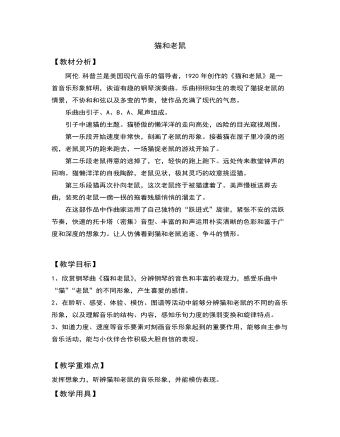
二年级音乐欣赏猫和老鼠教案教学设计
阿伦.科普兰是美国现代音乐的倡导者,1920年创作的《猫和老鼠》是一首音乐形象鲜明,诙谐有趣的钢琴演奏曲。乐曲栩栩如生的表现了猫捉老鼠的情景,不协和和弦以及多变的节奏,使作品充满了现代的气息。乐曲由引子、A、B、A、尾声组成。引子中速猫的主题。猫骄傲的懒洋洋的走向高处,凶险的目光窥视周围。第一乐段开始速度非常快,刻画了老鼠的形象。接着猫在屋子里冷漠的巡视,老鼠灵巧的跑来跑去,一场猫捉老鼠的游戏开始了。第二乐段老鼠得意的逃掉了,它,轻快的跑上跑下。远处传来教堂钟声的回响。猫懒洋洋的自我陶醉,老鼠见状,极其灵巧的故意挑逗猫。第三乐段猫再次扑向老鼠,这次老鼠终于被猫逮着了。美声慢板送葬去曲,装死的老鼠一瘸一拐的拖着残腿悄悄的溜走了。在这部作品中作曲家运用了自己独特的“跃进式”旋律,紧张不安的活跃节奏,快速的托卡塔(密集)音型、丰富的和声运用朴实清晰的色彩和富于广度和深度的想象力。让人仿佛看到猫和老鼠追逐、争斗的情形。
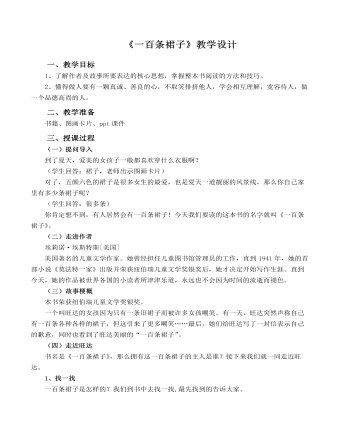
《一百条裙子》阅读课导读教案教学设计
1、书中还有许多描写旺达的片段,哪一处给你留下了深刻的印象呢?请同座位互相交流。全班交流。老师也想和大家一起分享一点感受。老师读第13页片段,并谈感受。课件出示:孤单,被嘲笑者2、你有过被人嘲笑的经历吗?谈一谈。旺达是怎样面对同学们的嘲笑?3、转学之后,十三班的同学们收到了她爸爸的来信。谁愿意读读这封信?圣诞节来临之际,旺达也写来一封信。学生读。读完这两封信,大家肯定感慨万千,一定有很多话想说吧?全班交流课件出示:善良 宽容
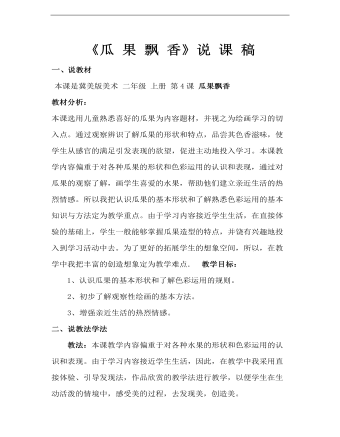
小学美术冀美版二年级上册《瓜果飘香》说课稿
教材分析:本课选用儿童熟悉喜好的瓜果为内容题材,并视之为绘画学习的切入点。通过观察辨识了解瓜果的形状和特点,品尝其色香滋味,使学生从感官的满足引发表现的欲望,促进主动地投入学习。本课教学内容偏重于对各种瓜果的形状和色彩运用的认识和表现,通过对瓜果的观察了解,画学生喜爱的水果,帮助他们建立亲近生活的热烈情感。所以我把认识瓜果的基本形状和了解熟悉色彩运用的基本知识与方法定为教学重点。由于学习内容接近学生生活,在直接体验的基础上,学生一般能够掌握瓜果造型的特点,并饶有兴趣地投入到学习活动中去。为了更好的拓展学生的想象空间,所以,在教学中我把丰富的创造想象定为教学难点.
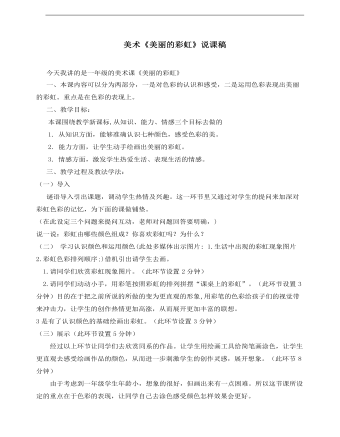
小学美术冀美版一年级上册《天边的彩虹》说课稿
(一)导入 谜语导入引出课题,调动学生热情及兴趣。这一环节里又通过对学生的提问来加深对彩虹色彩的记忆,为下面的课做铺垫。(在此设定三个问题来提问互动,老师对问题回答要明确,)说一说:彩虹由哪些颜色组成?你喜欢彩虹吗?为什么?(二) 学习认识颜色和运用颜色(此处多媒体出示图片: 1.生活中出现的彩虹现象图片2.彩虹色彩排列顺序;)借机引出请学生去画。 1.请同学们欣赏彩虹现象图片。(此环节设置2分钟)2.请同学们动动小手,用彩笔按照彩虹的排列拼摆“课桌上的彩虹”。(此环节设置3分钟)目的在于把之前所说的所做的变为更直观的形象,用彩笔的色彩给孩子们的视觉带来冲击力,让学生的创作热情更加高涨,从而展开更加丰富的联想。3是有了认识颜色的基础绘画出彩虹。(此环节设置3分钟)

小学美术冀美版二年级上册《4瓜果飘香》说课稿
二、说教法学法教法:本课教学内容偏重于对各种水果的形状和色彩运用的认识和表现。由于学习内容接近学生生活,因此,在教学中我采用直接体验、引导发现法,作品欣赏的教学法进行教学,以便学生在生动活泼的情境中,感受美的过程,去发现美,创造美。

小学美术冀美版一年级上册《9天边的彩虹》说课稿
(一)导入 谜语导入引出课题,调动学生热情及兴趣。这一环节里又通过对学生的提问来加深对彩虹色彩的记忆,为下面的课做铺垫。(在此设定三个问题来提问互动,老师对问题回答要明确,)说一说:彩虹由哪些颜色组成?你喜欢彩虹吗?为什么?(二) 学习认识颜色和运用颜色(此处多媒体出示图片: 1.生活中出现的彩虹现象图片2.彩虹色彩排列顺序;)借机引出请学生去画。
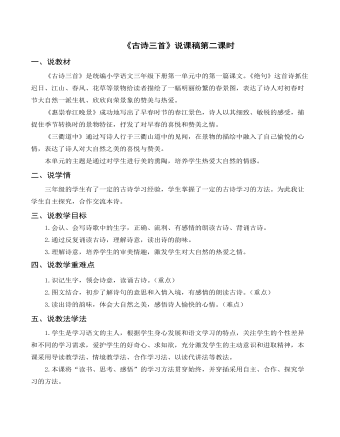
(说课稿)部编人教版三年级下册《古诗三首(二)》
一、说教材《古诗三首》是统编小学语文三年级下册第一单元中的第一篇课文。《绝句》这首诗抓住迟日、江山、春风、花草等景物给读者描绘了一幅明丽纷繁的春景图,表达了诗人对初春时节大自然一派生机、欣欣向荣景象的赞美与热爱。 《惠崇春江晚景》成功地写出了早春时节的春江景色,诗人以其细致、敏锐的感受,捕捉住季节转换时的景物特征,抒发了对早春的喜悦和赞美之情。 《三衢道中》通过写诗人行于三衢山道中的见闻,在景物的描绘中融入了自己愉悦的心情,表达了诗人对大自然之美的喜悦与赞美。本单元的主题是通过对学生进行美的熏陶,培养学生热爱大自然的情感。二、说学情 三年级的学生有了一定的古诗学习经验,学生掌握了一定的古诗学习的方法。为此我让学生自主探究,合作交流本诗。
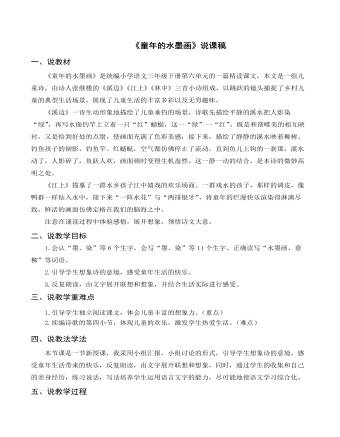
(说课稿)部编人教版三年级下册《童年的水墨画》
一、说教材《童年的水墨画》是统编小学语文三年级下册第六单元的一篇精读课文,本文是一组儿童诗,由诗人张继楼的《溪边》《江上》《林中》三首小诗组成,以跳跃的镜头捕捉了乡村儿童的典型生活场景,展现了儿童生活的丰富多彩以及无穷趣味。 《溪边》一诗生动形象地描绘了儿童垂钓的场景。诗歌先描绘平静的溪水把人影染“绿”,再写水面钓竿上立着一只“红”蜻蜓,这一“绿”一“红”,既是和谐唯美的相互映衬,又是恰到好处的点缀,使画面充满了色彩美感;接下来,描绘了静静的溪水映着柳树、钓鱼孩子的倒影、钓鱼竿、红蜻蜓,空气都仿佛停止了流动,直到鱼儿上钩的一刹那,溪水动了,人影碎了,鱼跃人欢,画面顿时变得生机盎然。这一静一动的结合,是本诗的微妙高明之处。 《江上》描摹了一群水乡孩子江中嬉戏的欢乐场面。一群戏水的孩子,那样的调皮,像鸭群一样钻入水中,接下来“一阵水花”与“两排银牙”,将童年的烂漫快乐渲染得淋漓尽致,鲜活的画面仿佛定格在我们的脑海之中。
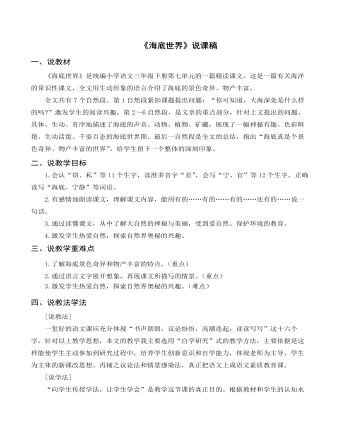
(说课稿)部编人教版三年级下册《 海底世界》
三、说教学重难点1.了解海底景色奇异和物产丰富的特点。(重点)2.通过语言文字展开想象,再现课文所描写的情景。(重点)3.激发学生热爱自然,探索自然界奥秘的兴趣。(难点)四、说教法学法[说教法]一堂好的语文课应充分体现“书声朗朗,议论纷纷,高潮迭起,读读写写”这十六个字。针对以上教学思想,本文的教学我主要选用“自学研究”式的教学方法,主要依据是这样能使学生主动参加到研究过程中,培养学生创新意识和自学能力,体现老师为主导,学生为主体的新课改思想。再辅之议论法和情景感染法,真正把语文上成语文素质教育课。[说学法]“向学生传授学法,让学生学会”是教学这节课的真正目的。根据教材和学生的认知水平,主要向学生渗透自学的方法,让学生会读书,重视朗读,组织学生多种形式的读。在多读的基础上,通过学生想、划、议等活动,调动学生积极思维。
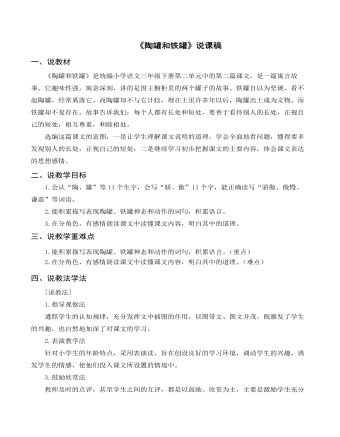
(说课稿)部编人教版三年级下册《 剃头大师》
三、说教学重难点1.能积累描写表现陶罐、铁罐神态和动作的词句,积累语言。(重点)2.在分角色、有感情朗读课文中读懂课文内容,明白其中的道理。(难点)四、说教法学法[说教法]1.指导观察法遵照学生的认知规律,充分发挥文中插图的作用,以图带文、图文并茂,既激发了学生的兴趣,也自然地加深了对课文的学习。 2.表演教学法 针对小学生的年龄特点,采用表演读,旨在创设良好的学习环境,调动学生的兴趣,诱发学生的情感,使他们投入课文所设置的情境中。 3.鼓励欣赏法 教师及时的点评,甚至学生之间的互评,都是以鼓励、欣赏为主,主要是激励学生充分地展示才能,满足他们希望得到赞许,体会成功的心理特点,激起学生学习的欲望,增强朗读的信心。